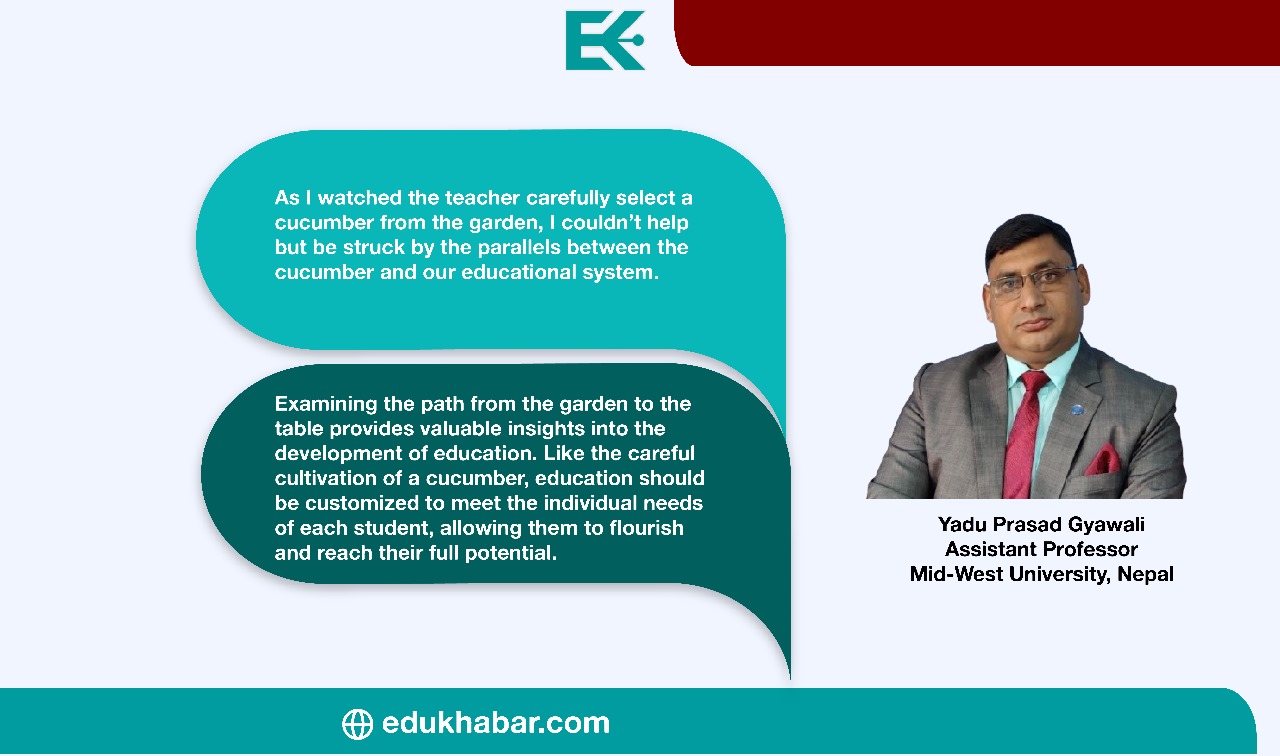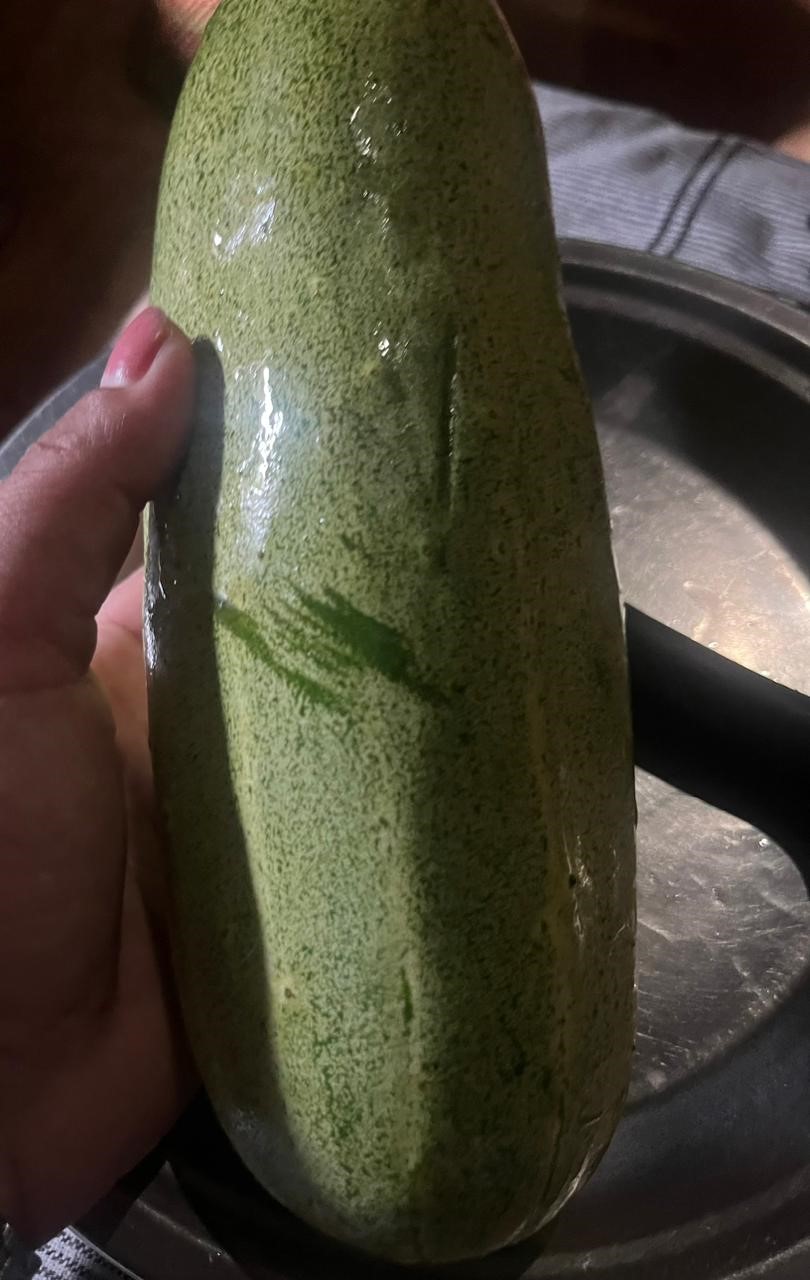
Recently, while travelling to a charming village of Karnali province, I had the pleasure of visiting a local teacher’s home. The visit was simple but enlightening. As we sat together over a warm cup of tea, something that deeply resonated with me. The teacher, known for his dedication to nurturing young minds, had a small garden that featured a vibrant patch of cucumbers. The sight of these cucumbers, cared for with such care, triggered a profound realization about the nature of education.

As I watched the teacher carefully select a cucumber from the garden, I couldn’t help but be struck by the parallels between the cucumber and our educational system. The teacher's approach to cultivating these cucumbers, from their growth in the field to their preparation for our meal, became a powerful metaphor for the way we approach teaching and learning. The cucumber, with its smooth, glossy surface and subtle ridges, embodies the state of modern education. At first glance, it appears simple and unassuming, yet beneath its exterior lies a rich tapestry of complexities and potential. The journey from the garden to our plate illustrates the care, attention, and adaptability required in education. This chance encounter, combined with my reflections on cucumber, led me to explore the acronym CUCUMBER, which captures the qualities and strategies essential for a vibrant and effective educational system.
Cultivation of Knowledge
The teacher’s approach to his cucumbers highlights the importance of careful cultivation. Each cucumber was nurtured with precision, soaked in just the right amount of water, given ample sunlight, and protected from pests. This careful attention ensured that the cucumbers reached their full potential. Similarly, in education, we must create a fertile environment that supports both academic and personal growth. This involves providing resources, infrastructure, and a supportive environment in which students can thrive.
Understanding Individual Needs
The teacher’s garden was a testament to personalized care. He recognized that different cucumbers required different levels of attention according to their stage of growth and environmental conditions. This approach is similar to understanding the unique needs of each student. Just as the teacher adjusted his care for each cucumber, educators must tailor their methods to accommodate the diverse strengths and learning styles of their students.
For example, in a classroom setting, this could mean using differentiated instruction to cater to various learning preferences. A student who excels in visual learning might benefit from diagrams and videos, while another who thrives in hands-on environments could engage more with practical experiments. By personalizing learning experiences, educators can help each student reach their full potential.
Cultivating Curiosity and Creativity
Observing how teacher cucumbers added zest to our meal underscored the importance of making education engaging and stimulating. The freshness and flavour of cucumber made it a delightful part of our teatime. Similarly, education should captivate students’ imaginations and foster curiosity, creativity, and critical thinking.
For instance, in an art class, instead of solely focusing on techniques, a teacher might encourage students to explore their own artistic styles and ideas. By allowing students to experiment and express their creativity, education becomes a more enriching and engaging experience, much like how a cucumber enhances the meal with its unique flavor.
Useful Learning and Adaptability
Even after being picked, the cucumber continues to contribute to various dishes, symbolizing the concept of lifelong learning. Education should be a continuous journey, adapting to the changing needs and circumstances of individuals. An example of this in practice is the integration of ongoing professional development for educators.
Just as a gardener learns new techniques to improve cucumber yield, teachers can benefit from continuous learning opportunities to stay up to date with educational advancements. This commitment to growth ensures that educators can provide the best possible support to their students, preparing them for a rapidly changing world.
Maximizing Potential
The dedication to his cucumbers illustrated the importance of maximizing potential. Each cucumber, given the right care, has the potential to be a valuable part of a meal. This principle also applies to students. Each student has unique abilities and the potential to have a significant impact. Educators must work to unlock and enhance this potential through tailored support, encouragement, and opportunities for growth. Consider the example of a student who struggles with traditional testing but excels at project-based learning.
By recognizing and nurturing this student’s strengths, a teacher can provide opportunities for success that might not be apparent through standard assessments. This approach not only helps the student achieve their best, but also contributes positively to their overall learning experience.
Building resilience
The resilience of cucumbers, capable of adapting to various growing conditions, is a metaphor for the resilience needed in education. Students should be equipped with the skills to face challenges and adapt to changing circumstances. For example, consider a student who faces difficulties with a particular subject. Instead of viewing this challenge as a setback, educators can support the student by providing additional resources, offering encouragement, and helping him develop problem-solving skills. This approach builds resilience and prepares students to overcome obstacles with confidence and resourcefulness.
Embracing Innovation
The versatility of cucumbers in various cuisines illustrates the importance of innovation. Just as cucumbers can be used in different dishes to add unique flavors, education should embrace new methods, technologies, and ideas to enhance the learning experience. An example of innovation in education could be the incorporation of Information and Communication tools and techniques with reference to the available tools or applications.
ICT tools engage students in creative activities, educators can provide a more engaging and interactive learning experience as well. Embracing such innovations ensures that education remains relevant and effective in a rapidly evolving world.
Renewing the Educational Landscape
Our education system should adapt to student and societal needs like a cucumber. By using current and flexible methods, we may create an education system that meets individual requirements, engages students, and accommodates varied learning styles.
This change relies on a very efficient, rapid evaluation system. Conventional testing methods often fail to assess a student's creativity and problem-solving skills. We need comprehensive evaluation methods that assess academic knowledge and 21st-century abilities like critical thinking, collaboration, interpersonal skills, and flexibility. The exams should be updated, ongoing, and focused on improvement to give students feedback and help them grow.
Tech integration is key in this new educational system. We use cutting-edge technology to create interesting and engaging educational experiences that match each student's specific learning needs and encourage independent study. Digital tools and platforms allow students to access a wide range of resources, collaborate globally, and develop digital literacy, which is essential in the current world.
New technology allows real-time data analysis for better student progress tracking and individualized learning pathways. We want to create a future of creative, passionate, resilient, and knowledgeable learners. These individuals will be ready to deal with today's complex society with an established basis in modern skills and cutting-edge evaluation methodologies. Education maintains and promotes intellectual and personal growth in our ever-changing global society.
What next?
Examining the path from the garden to the table provides valuable insights into the development of education. Like the careful cultivation of a cucumber, education should be customized to meet the individual needs of each student, allowing them to flourish and reach their full potential. Future educational practices should prioritize personalized learning approaches that cater to individual strengths and preferences. It is crucial to foster creativity and curiosity by implementing innovative and engaging methods.
Continuous professional development for educators is crucial to ensure that they stay up to date with the latest advancements and adjust their teaching strategies accordingly.
Embracing technological advancements and nurturing adaptability will greatly improve the learning journey, equipping students to navigate a dynamic and evolving world. Through the implementation of innovative educational methods and a focus on individualized learning, we could cultivate a vibrant and stimulating educational system that fosters growth and development, much as the cucumber provides essential nourishment.
प्रतिक्रिया